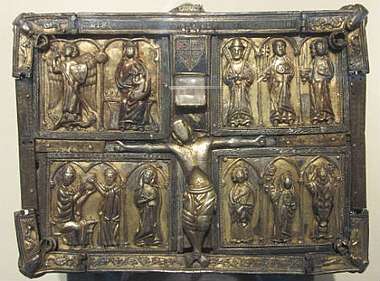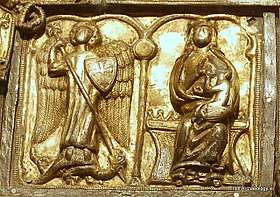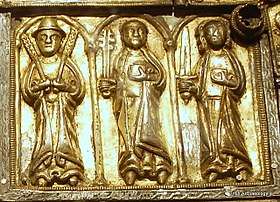Domhnach Airgid

The Domhnach Airgid (English: Sliver Church) is an 8th-century Irish metalwork and wooden book shrine of the cumdach type, held at the National Museum of Ireland in Dublin[1] since 1847.[2] It is traditionally associated with Saint Patrick, who was thought to have had it in his possession at one point.
Domhnach Airgid comprises two separate main elements: an outer casket or box and the fragments of a 6th-9th century manuscript it was built to hold. The wooden oblong box is heavily inscribed, with lettering running right around the outer borders, and it is covered by silver and bronze panels which contain fragments of vellum manuscript of the Gospels written in Latin.[3] Thirty-nine pages of the manuscript survive,[2] each about nine inches in height.[4]
The shrine was redesigned c 1350, when the much of the extant metalwork and relief plaques on the cover were added. The work is thus a mixture of the non-contemporary Insular art and International Gothic styles.
Design

Domhnach Airgid's casket was designed to hold relics and consists of three covers, with the center one being made of wood, probably from yew. Another is made from copper, plated with silver. The outer cover, pictured above, is of the highest quality, and lined with silver and decorated by gilding.[5] The cover contains a series of elevated carving centered on a representation of Jesus on the cross surrounded by eleven smaller sized figures, including a grouping of three apostles, probably James, Peter and Paul, the panel showing the Archangel Michael and the Virgin and Child, a panel with a grouping of Saint Colmcille, St. Brigid and Patrick, while with the saint at the lower right is thought to represent of Patrick presenting a cumdach to St. Macartan.[6] The corners of the frontispiece contain a series of running animals or grotesques placed on small mounts. A dove, representing the Holy Spirit and decorated with a crystal, hovers above Christ's head.[7]
The figures are ornately and delicately carved. The cover was built to hold a number of relics, by legend associated with Patrick. In this tradition, the shrine was thought to have been in his possession and was sanctified by him[4] before he gave it to St. Macartan. It thus became a significant and prized object that was widely venerated.[8]

The case was significantly remodeled around 1350 (a dating established by George Petrie) by the goldsmith John O’Bardan, during work commissioned by John O’Carbri, abbot of Clones. O’Bardan, whose signature appears on the object and is known to have lived in Drogheda, modernised the appearance of the shrine in the contemporary International Gothic style,[8][9] and added the figures of Jesus and the saints.[8] O’Carbri likely had political motivations for commissioning the redesign in the context of the Anglo-Norman invasion of Ireland. The Normans sought to undermine the established order, in part by undermining and reforming Irish Christianity, while seeking to detach it from its Celtic basis. In response, some clerics fought back by refurbishing and restoring early medieval sacred objects in order to reinforce the island's cultural identity.[8]
Due to its age, the Domhnach Airgid is not in good condition. Areas of the gilding contain accumulations of dirt, and any colourisation has long since faded, giving it its current dark appearance of mostly brown and black hues.[4]
Manuscript
The manuscript is of the Cathach (literally "Battle Book") style,[4] indicating an apocryphal use as a rallying cry or protector in battle. There are 39 surviving leaves, with text written in the Irish majuscule script.[2] The manuscript leaves are very worn down, and some have become detached from their casing.[4]
References
- ↑ "The Domhnach Airgid". Cultural Heritage Ireland. Retrieved 1 April 2018
- 1 2 3 Diringer (1986), 464
- ↑ "The Study of Celtic Literature". The Cornhill magazine, Volume 11; Volume 13. Guildford: Cornhill 1993. p. 296
- 1 2 3 4 5 O'Curry (1861), 12
- ↑ O'Curry (1878), 322
- ↑ "The Domhnach Airgid, an Early Irish Book Shrine". Irish Archaeology, 2015. Retrieved 1 April 2018
- ↑ O'Curry (1878), 323
- 1 2 3 4 O'Toole (2013), 98
- ↑ Hourihane (2012), 510
Sources
- Arnold, Matthew. The Study of Celtic Literature. London: Smith, Elder, & Co, 1891
- Diringer, David. The Book Before Printing: Ancient, Medieval and Oriental. Dover: Dover Publications Inc., 1986. ISBN 978-0-4862-4243-9
- Hourihane, Colum. 'The Grove Encyclopedia of Medieval Art and Architecture, Volume 1. Oxford: Oxford University Press, 2012. ISBN 978-0-1953-9536-5
- O'Curry, Eugene. "Ancient Irish Historical Manuscripts". Dublin Review, Thomas Richardson & Son, 1861
- O'Curry, Eugene. "Lectures on the manuscript materials of ancient Irish history: delivered at the Catholic University of Ireland, during the sessions of 1855 and 1856 (1878)". ReInk Books, 2018; reprint of the 1878 edition
- O'Toole, Fintan. A History of Ireland in 100 Objects. Dublin: Royal Irish Academy, 2013. ISBN 978-1-9089-9615-2